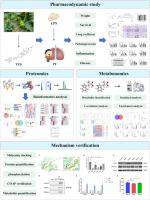Integrative proteomics and metabolomics reveal that Terrestris saponin D ameliorates pulmonary fibrosis by regulating unsaturated fatty acid biosynthesis
IF 8.3
1区 医学
Q1 CHEMISTRY, MEDICINAL
引用次数: 0
Abstract
Background
Pulmonary fibrosis (PF) is a chronic, progressive interstitial lung disorder with an unclear pathogenesis and irreversible progression. Terrestris saponin D (TED), a bioactive compound from the traditional medicinal herb Tribulus terrestris, has demonstrated significant inhibitory effects on PF progression. However, its specific molecular targets in PF treatment and underlying regulatory mechanisms at the proteomic and metabolic levels remain to be fully elucidated.
Purpose
This study aims to comprehensively analyze the potential pharmacological mechanisms of TED in ameliorating PF by investigating dynamic correlations at both the proteomic and metabolic levels. It also seeks to transcend the limitations of traditional single-target paradigms by identifying novel functions of key proteins involved in TED-mediated PF amelioration and elucidating TED’s regulatory effects on critical metabolic pathways. This research provides an innovative theoretical basis for understanding how individual components of traditional Chinese medicine can intervene in complex diseases, establishing a new direction for developing anti-PF treatment strategies based on metabolic regulation.
Study design/Methods
The anti-PF efficacy of TED was evaluated in a murine PF model by assessing lung histopathology and inflammatory/fibrotic markers. Integrative 4D-SmartDIA quantitative proteomics and untargeted metabolomics explored its mechanisms in pulmonary fibrosis progression, with findings validated by correlation analyses and further experiments.
Results
TED mitigated PF progression by suppressing inflammatory responses and reducing collagen deposition. Quantitative 4D-SmartDIA proteomics analysis identified stearoyl-CoA desaturase 2 (SCD2) as a potential target of TED in PF. Dynamic metabolic profiling demonstrated that TED administration restores dysregulated endogenous metabolism involving arachidonic acid, carnosine, and proline metabolic pathways during fibrotic progression. These findings implicate SCD2-mediated biosynthesis of unsaturated fatty acids (UFAs) as the primary mechanism underlying TED’s anti-PF effects. Computational docking analyses confirmed stable, spontaneous binding between TED and SCD2. Subsequent Western blotting revealed that TED upregulates SCD2 expression and phosphorylation. Additional studies suggest that TED ameliorates PF by modulating unsaturated fatty acid (UFA) levels, consistent with the omics findings. Co-immunoprecipitation (Co-IP) was used to assess SCD2 phosphorylation.
Conclusion
These findings indicate that TED alleviates PF by modulating SCD2 expression and phosphorylation, thereby influencing UFAs biosynthesis. These results highlight potential molecular targets for TED therapy and provide insight into novel regulatory mechanisms of SCD2 in PF.

综合蛋白质组学和代谢组学研究表明,地草皂苷D通过调节不饱和脂肪酸的生物合成来改善肺纤维化
肺纤维化(PF)是一种慢性进行性间质性肺疾病,发病机制不明确,进展不可逆。土蒺藜皂苷D (TED)是一种从传统草药蒺藜中提取的生物活性化合物,对PF的进展有显著的抑制作用。然而,其在PF治疗中的特定分子靶点以及在蛋白质组学和代谢水平上的潜在调节机制仍有待充分阐明。目的通过研究蛋白质组学和代谢水平上的动态相关性,综合分析TED改善PF的潜在药理学机制。它还试图通过鉴定参与TED介导的PF改善的关键蛋白的新功能,并阐明TED对关键代谢途径的调节作用,从而超越传统单靶点范式的局限性。本研究为理解中药单体成分如何干预复杂疾病提供了创新的理论基础,为开发基于代谢调节的抗pf治疗策略开辟了新的方向。研究设计/方法通过肺组织病理学和炎症/纤维化标志物的测定,在小鼠PF模型中评价TED的抗PF效果。整合4D-SmartDIA定量蛋白质组学和非靶向代谢组学探讨了其在肺纤维化进展中的机制,相关分析和进一步的实验验证了这些发现。结果,通过抑制炎症反应和减少胶原沉积,减轻了PF的进展。定量4D-SmartDIA蛋白质组学分析发现硬脂酰辅酶a去饱和酶2 (SCD2)是PF中TED的潜在靶点。动态代谢分析表明,在纤维化进展过程中,TED可以恢复包括花生四烯酸、肌肽和脯氨酸代谢途径在内的失调内源性代谢。这些发现暗示scd2介导的不饱和脂肪酸(UFAs)的生物合成是TED抗pf作用的主要机制。计算对接分析证实了TED和SCD2之间稳定、自发的结合。随后的Western blotting显示,TED上调SCD2的表达和磷酸化。其他研究表明,TED通过调节不饱和脂肪酸(UFA)水平来改善PF,这与组学研究结果一致。共免疫沉淀(Co-IP)用于评估SCD2磷酸化。结论TED通过调节SCD2的表达和磷酸化来缓解PF,从而影响UFAs的生物合成。这些结果突出了TED治疗的潜在分子靶点,并为SCD2在PF中的新调控机制提供了见解。
本文章由计算机程序翻译,如有差异,请以英文原文为准。
求助全文
约1分钟内获得全文
求助全文
来源期刊

Phytomedicine
医学-药学
CiteScore
10.30
自引率
5.10%
发文量
670
审稿时长
91 days
期刊介绍:
Phytomedicine is a therapy-oriented journal that publishes innovative studies on the efficacy, safety, quality, and mechanisms of action of specified plant extracts, phytopharmaceuticals, and their isolated constituents. This includes clinical, pharmacological, pharmacokinetic, and toxicological studies of herbal medicinal products, preparations, and purified compounds with defined and consistent quality, ensuring reproducible pharmacological activity. Founded in 1994, Phytomedicine aims to focus and stimulate research in this field and establish internationally accepted scientific standards for pharmacological studies, proof of clinical efficacy, and safety of phytomedicines.
 求助内容:
求助内容: 应助结果提醒方式:
应助结果提醒方式:


